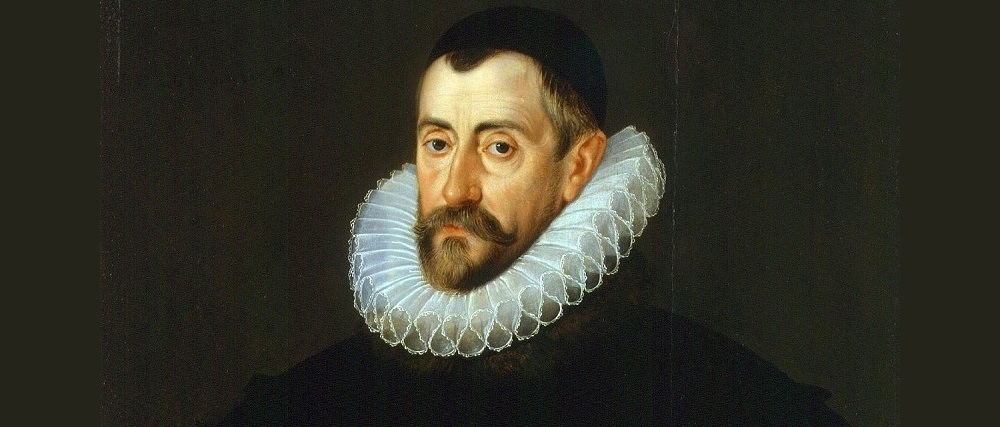Francis Walsingham
Posted on 30th January 2021
Francis Walsingham was born around 1532, probably as Foots Cray near Chislehurst, Kent, to parents William Walsingham, a lawyer and Joyce Denny.
Walsingham enrolled at Kings College, Cambridge in 1548, then left to travel abroad in 1550, returning to enrol at Gray’s Inn, one of the Inns of Court in 1552.
Catholic Mary I came to the throne in 1553 leaving numerous prominent Protestants in danger, and many of them including Walsingham fled abroad; he did however continue his law studies while abroad.
After Mary I’s death in 1558, her half-sister the Protestant Elizabeth I came to the throne. It was now safe for Walsingham to return.
With the help of Francis Russell, 2nd Earl of Bedford, Walsingham was elected as a member of parliament for Bossiney, Cornwall in 1559 and Lyme Regis in 1563.
Over the years, Walsingham became active in raising support for the Protestant Huguenots in France. He started working for Elizabeth’s chief adviser William Cecil and became known as the Spymaster, collecting information to thwart plots against Elizabeth, further raising his profile by being instrumental in the collapse of the Ridolfi Plot in 1571. This was planned by Roberto Ridolfi to assassinate Elizabeth I and replace her on the throne with Mary, Queen of Scots.
Walsingham became Ambassador in France in 1570 and was involved in marriage negotiations for Elizabeth to marry Henry, Duke of Anjou. After the breakdown of these negotiations, Henry’s younger brother Francis, Duke of Alencon was proposed, but in the end, instead of marriage a military alliance was agreed, leading to the Treaty of Blois in 1572.
Walsingham returned to England in 1573 and was appointed to the Privy Council in December of that year being named a principal secretary. He was then knighted on 1 December 1577.
There were no specific duties of a principal secretary, therefore Walsingham became involved in many fields of government, influencing policy both in England and abroad. He embarked on many diplomatic missions abroad, gathering information himself and installing several spies in the foreign courts.
In 1578 Walsingham was sent to the Netherlands to negotiate a peace treaty. He was in favour of supporting the Protestant revolt in the Netherlands against Spain, but Elizabeth was more cautious and preferred peace. While in the Netherlands though, he was, as always to be the Spymaster and gather intelligence.
In 1579 Elizabeth was keen to renew marriage negotiations with Francis, Duke of Alencon, sending Walsingham to France in 1581 to agree this. Walsingham however returned without an agreement. He was against the marriage anyway as Alencon was a Catholic, and England was a Protestant country. With Elizabeth not having an heir, a marriage between the two may have caused England to fall into the clutches of the French.
Walsingham’s next mission was to Scotland in 1583, but discussions with James VI of Scotland were mainly unsuccessful. Eventually they mutually agreed peace with the Treaty of Berwick in 1586.
Walsingham had a complete hatred for Catholics. He intercepted their letters, and gathered information about them and their supposed conspiracies from his spies. He interrogated and even tortured Catholic priests and others, many of which he then executed.
In 1582 Walsingham intercepted letters between the Spanish Ambassador and Scotland. These letters showed details of a conspiracy by Catholics to depose Elizabeth I and place Mary, Queen of Scots on the throne of England.
This was known as the Throckmorton Plot, and the instigator Francis Throckmorton was tortured until he confessed, and then executed in 1584.
Walsingham would further expose a second plot against Elizabeth, in which he would finally have his wish to be rid of Mary, Queen of Scots.
Mary had been imprisoned in England since 1568, but while alive she would always be a threat to Elizabeth’s throne. Walsingham placed a spy in the camp of the conspirators and intercepted letters between Mary, Queen of Scots and Anthony Babington.
He continued to gather his intelligence and trapped Mary, proving she was complicit in the Babington plot. Anthony Babington and others were executed in September 1586. Mary, Queen of Scots was beheaded on 8 February 1587.
Walsingham continued to serve Elizabeth until his death. His spy network was wide and continued to pass information about a possible war with Spain. Walsingham supported Francis Drake’s raid on Cadiz in 1587 which heavily affected Spain’s preparations and his spies were involved with passing false information to confuse the Spanish while they were preparing the Spanish Armada of 1588.
Francis Walsingham died at home on 6 April 1590 and is buried in St Paul’s Cathedral.
He had married twice, first to the Lord Mayor of London’s daughter Anne in 1562, who died in 1564 and to Ursula St Barbe in 1566 whom he had two daughters with. She outlived Walsingham, dying in 1602.
Tagged as: Junior Tudors
Share this post:





